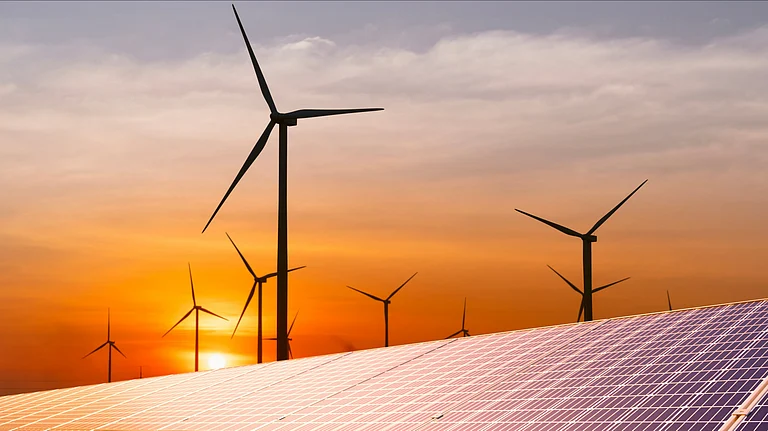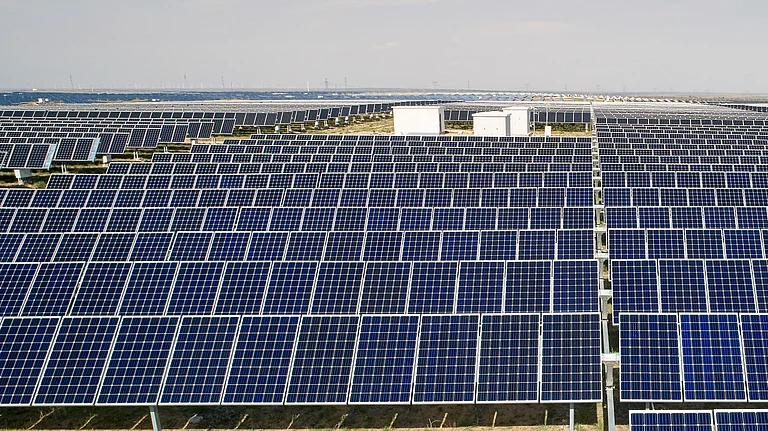The Central Electricity Authority (CEA) has proposed the installation of automatic weather stations at wind and solar plants of 50 MW or above by the developer, in a notification published on July 7.
In order to enhance the cost efficiency and stability of the grid, the CEA issued an advisory in February, co-locating energy storage systems with solar power projects.
The report, flagging the dependency of solar and wind generation on weather conditions, stated that the lack of accurate, timely forecast poses challenges to stable energy generation. To add to the woes, forecasting errors result in significant financial penalties under the Deviation Settlement Mechanism (DSM).
Understanding DSM Penalties
According to Council of Energy, Environment and Water (CEEW), any demand-supply imbalance of electricity leads to a fluctuation in the grid frequency from the standard value, which is set at 50 Hertz (Hz) in India.
A significant drop or rise in frequency could lead to a power system blackout. Therefore, the Indian Electricity Grid Code (IEGC) 2010 restricts the operational frequency between 49.90 to 50.05 Hz.
To maintain the frequency within the band, the power distribution companies must predict demand accurately and schedule supply accordingly.
Grid operators use ancillary services to maintain grid frequency and ensure system security at all instances and restore system security in real time. Ancillary services are a collection of secondary services that transmission system operators (TSOS) purchase to keep the electricity stable and reliable which include frequency regulation, spinning reserve, voltage control, and black-start capability.
Any demand-supply imbalance of electricity leads to a fluctuation in the grid frequency from the standard value. Maintaining specific system frequency is a challenging task as the grid itself cannot store or buffer electricity.
When the demand and supply fail to match due to forecast error, sudden weather events or generator outages—grid operators call on ancillary services to correct imbalances and avert blackouts.
Ancillary services require generators or storage systems to remain on standby or operate flexibly to respond to real-time needs, making them more expensive than scheduled energy due to idle capacity and quick response requirements. Therefore, ancillary services are naturally more expensive than the usual planned, contracted electricity supply which the generators are expected to deliver to the consumers.
How AWS Help Grids
In its report, the CEA also stated that it has prepared guidelines for the installation of AWS and directed all renewable energy implementing agencies to include AWS requirements in their bid documents.
“Accurate measurement of critical meteorological parameters would optimise RE generation. Also, it would improve overall generation predictability, efficiency, enhance grid reliability and ensure regulatory compliance,” the document stated.
The automatic weather station should be located within the renewable energy project site, according to guidelines. “For solar power plants, the AWS should be located in terrain that closely resembles the overall site conditions, with irradiance sensors mounted at the same tilt and orientation as the photovoltaic modules. For wind power projects, the AWS must be positioned in areas that reflect the true wind regime of the site, turbulence zones, or artificial barriers,” outlined the CEA guideline.
Typically, one AWS per RE plant is to be installed for 50 MW and above RE (or as per respective State Electricity Regulatory Commissions (SERC) regulation capacity connected at intra state network and Inter-State Transmission System (ISTS) connected RE plants shall be governed by respective regulations of Central Electricity Regulatory Commission (CERC).
IMD’s Expansion Plans
According to a 2024 report published by IMD and Ministry of Earth Science’ Vision 2047 framework, the history of Automatic Weather Stations (AWS) in India dates back to 1980 when India Meteorological Department (IMD) conducted a pilot experiment with Indian Space Research Organization (ISRO) to operate a small network of Data Collection Platforms (DCP) via SEO satellite to the receiving station located at Shriharikota Rocket Range. Thereafter, IMD established a network of 100 Data Collection Platforms (DCPs) across India in the 1980s.
Fast forward to 2025, IMD has established a network of 1008 AWS, 200 AGRO AWS and 1382 ARG Network.
Maintaining a grid gets challenging but grid integration of renewable energy further adds to the challenge because of unpredictable nature of solar and wind energy especially when the weather turns erratic due to climate change. This green transition is revealing significant vulnerabilities in the national grid. Solar and wind energy, with their inherent variability, depend on unpredictable weather patterns, unlike traditional power plants,” stated a February report by IFRI, a French think tank. “This challenge is magnified by India’s tight operating frequency band of 49.90 Hz to 50.05 Hz, where even slight fluctuations can cause grid instability. Climate change is only heightening this risk,” added IFRI.
This gap makes the AWS network under-utilised and less effective in supporting forecasting.
Experts, according to Mongabay, cautioned that climate change is further complicating forecasts. Madhavan Nair Rajeevan, Vice Chancellor of Atria University and former Secretary, Ministry of Earth Sciences, told Mongabay that while general weather forecasting in India is reasonably good, it struggles when it comes to extreme weather events. “The monsoon is changing. It no longer behaves according to textbook patterns.”
The Vision-2047 framework also underscored IMD’s short-term target to expand its automated observational network to cover 800 districts and 1,50,000 blocks within two years and further extend the network to 2,50,000 panchayats over the next 10 years as part of its medium-term vision.


































